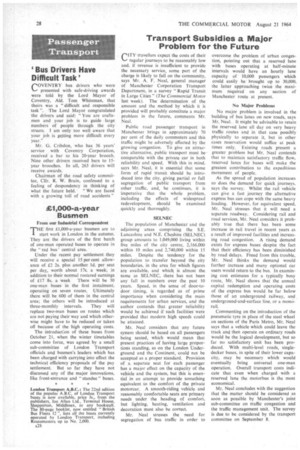Transport Subsidies a Major Problem for the Future
Page 32

If you've noticed an error in this article please click here to report it so we can fix it.
Cay travellers expect the costs of their regular journeys to be reasonably low and, if revenue is insufficient to provide the necessary service, some part of the charge is likely to fall on the community, says Mr. A. F. Neal, general manager of Manchester Corporation Transport Department, in a survey "Rapid Transit in Large Cities" (The Commercial Motor last week). The determination of the amount and the method by which it is provided will probably constitute a major problem in the future, comments Mr. Neal.
Public road passenger transport in Manchester brings in approximately 70 per cent of the daily commuters and this traffic might be adversely affected by the growing congestion. To give an attractive alternative, public transport must be comparable with the private car in both reliability and speed. With this in mind. says Mr. Neal, it is essential that some form of rapid transit should be introduced into the city, giving partial or full segregation of public transport from other traffic, and, he continues, it is imperative that the whole problem, including the effects of widespread redevelopment, should be examined _quickly and thoroughly.
The population of Manchester and the adjoining areas comprising the S.E. Lancashire and N.E. Cheshire (SELNEC) group amounts to 1,049,000 living within five miles of the city centre, 2,166,000 within 10 miles and 2,740,000 within 15 miles. Despite the tendency for the population to transfer beyond the city boundaries, in the area for which figures are available, and which is almost the_ same as SELNEC, there has not been any fall in numbers over the past 10 years. Speed, in the sense of door-todoor timing, is regarded as of prime importance when considering the main requirements for urban services, and the author contends that greater reliability would be achieved if such facilities were provided that modern high speeds could be attained.
Mr. Neal considers that any future system should be based on all passengers being seated, which would mean that present practices of having large proportions standing, as on the London Underground and the Continent, could not be accepted as a proper standard. Provision of a, separate seat for each passenger has a major effect on the capacity of the vehicle and the system, but this is essential in an attempt to provide something equivalent to the comfort of the private motorcar. A smooth-riding vehicle and reasonably comfortable seats are primary needs under the heading of comfort, but lighting, heating, ventilation and decoration must also be correct.
Mr. Neal stresses the need for segregation of bus traffic in order to overcome the problem of urban congestion, pointing out that a• reserved lane with buses operating at half-minute intervals would have an hourly lane capacity of 10,000 passengers which could easily be brought up to 30,000, the latter approaching twice the maximum required on any section of Manchester route at present.
No Major Problems
No major problem is involved in the building of bus lanes on new roads, says Mr, Neal. It might be advisable to retain the reserved lane all day on very heavy traffic routes and in that case possibly physically to separate it, but in other cases reservation would suffice at peak times only. Existing roads present a greater problem but Mr. Neal contends that to maintain satisfactory traffic flow, reserved lanes for buses will make the greatest contribution to the expeditious movement of people.
As the spread of population increases so does the demand for quick journeys, says the survey. Whilst the rail vehicle can give a fast journey the alternative express bus can cope with the same heavy loading. However, for equivalent speed, Mr. Neal stresses that it will need a separate roadway. Considering rail and road services, Mr. Neal considers it probably true that there has been some increase in rail travel in recent years as a result of improved facilities and increasing road congestion. A rising demand exists for express buses despite the fact that their efficiency has been diminished by road delays. Freed from this trouble, Mr. Neal thinks the demand would further increase and many optional car users would return to the bus. In examining cost estimates for a typically busy route, Mr. Neal shows that the annual capital redemption and operating costs of the express bus would be far below those of an underground railway, and underground-and-surface line, or a monorail.
Commenting on the introduction of the pneumatic tyre in place of the steel wheel on sections of the Paris Metro, Mr. Neal says that a vehicle which could leave the track and then operate on ordinary roads would be the logical development, but so far no satisfactory unit has been produced. With multi-level roads, singledecker buses, in spite of their lower capacity, may be necessary which would eventually bring universal one-man operation. Overall transport costs indicate that even when charged with a reserved lane the motorbus is the most economical.
Mr. Neal concludes with the suggestion that the matter should be considered as soon as possible by Manchester's joint sub-committee on traffic congestion and the traffic management unit. The survey is due to be considered by the transport committee on September 8.






















































































































